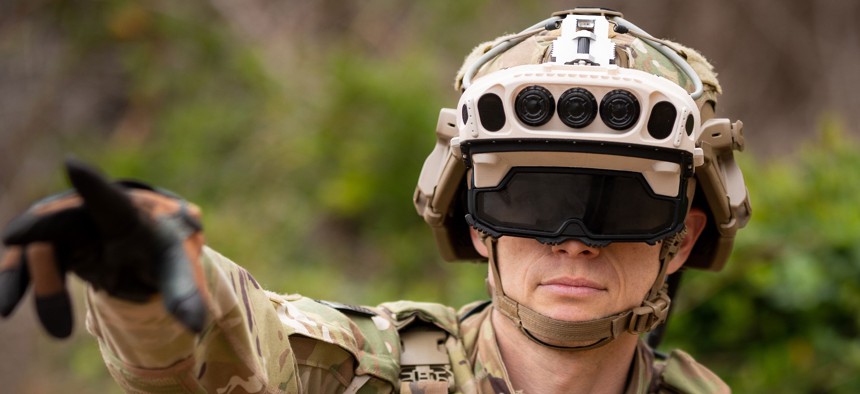Army gets new prototypes of Microsoft’s augmented reality headsets

One of 20 prototypes of Microsoft's new version of its VR headset delivered to the Army last month. Frederick Shear/U.S. Army
The military branch plans to begin testing the updated variant of its Integrated Visual Augmentation System this month.
The U.S. Army announced last week that it has received prototypes for the latest variant of its augmented reality headset and plans to begin testing them sometime this month.
According to a July 28 release from the Pentagon’s Defense Visual Information Distribution Service, Army officials received 20 prototypes of the 1.2 variant of the Integrated Visual Augmentation System — or IVAS — last Tuesday.
The augmented reality headsets feature a heads-up display that integrates “next-generation situational awareness tools and high-resolution simulations to provide soldiers with improved mobility and lethality in combat environments,” according to the Army.
The service said it plans to feature the latest headset prototypes during a user assessment this month, in which “two squads of soldiers will use IVAS 1.2 to measure the system’s performance and ensure engineering efforts are on schedule and meeting design objectives.”
The service announced a 10-year contract with Microsoft — worth as much as $21.88 billion — in March 2021 to develop the equipment, which is based on the technology company’s HoloLens headset. Following testing of the 1.0 prototype of the system, the Army awarded Microsoft a task order in December 2022 to develop the 1.2 variant of the device.
Delivery of the IVAS 1.2 prototypes comes as the Army’s effort to develop an augmented reality headset has faced delays and scrutiny from DOD officials about the equipment’s usability. The Pentagon’s Office of Inspector General warned in an April 2022 report that DOD’s inability to determine “minimum user acceptance levels” when testing the headsets could result in the department wasting billions of dollars on a system that soldiers may not want to use.
During testing of the IVAS 1.0 prototype last year, soldiers were found to be “more successful accomplishing their operational missions with their current equipment than with IVAS 1.0,” according to the fiscal year 2022 report from the Pentagon’s Office of the Director of Operational Test and Evaluation.
The report also noted that “the majority of soldiers reported at least one symptom of physical impairment to include disorientation, dizziness, eyestrain, headaches, motion sickness and nausea, neck strain and tunnel vision” when using the IVAS 1.0 headset.
Col. Anthony Gibbs — head of the Army’s Project Manager Soldier Warrior office — noted in a statement that soldiers’ feedback following last year’s operational testing was instrumental in developing the updated headset.
“We took those lessons learned and all that soldier feedback and in less than a year have what we now call version 1.2 of the system,” Gibbs said, adding that Army officials believe the latest variant is “really going to hit the mark in terms of what we need to put out there for our soldiers to give them the situational awareness and the leap-ahead capability they need to stay ahead of our peers.”
The Army plans to use earlier variants of IVAS for training purposes, while the service’s close combat force is set to receive IVAS 1.2.
A Microsoft spokesperson also noted in a statement to Nextgov/FCW that delivery of the IVAS 1.2 prototypes “is three months ahead of schedule and part of our commitment to move with speed to deliver on this critical program.”
“Microsoft is collaborating closely with the U.S. Army to develop the next iteration of the IVAS headset that improves on earlier variants with a slimmer, lighter and more balanced form factor to greatly improve soldier comfort and performance,” the spokesperson added.
Douglas R. Bush, the Army's acquisition chief, told Congress this April that the service hopes to bring the IVAS program into full production as soon as summer of 2025.






